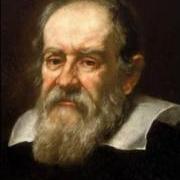- 1610: Galileo
- 1676: Ole Rømer
- 1687: Isaac Newton
- 1781: William Herschel
- 1838: Friedrich Bessel
- 1861: William and Margaret Huggins
- 1912: Henrietta Leavitt
- 1917 Einstein
- 1920: Harlow Shapley
- 1929 Edwin Hubble
- 1948: Ralph Alpher
- 1949: Fred Hoyle
- 1963: Maarten Schmidt
- 1964: Arno Penzias and Robert Wilson
- 1978: Vera Rubin and Kent Ford
- 1989: Margaret Geller and John Huchra
- 1992: John Mather and George Smoot
- 1995: Robert Williams
- 1998: Saul Perlmutter and Brian Schmidt
- 2010: Wendy Freedman
1610: Galileo Galilei Observes the Moons of Jupiter
 |
| Portrait of Galileo Galilei by Justus Sustermans 1636. |
Nearly all cultures have a vision of the cosmos as a whole. The earliest cosmologies of the great civilizations in Egypt, India, Babylonia, and the Americas shared the idea that Earth is flat, and that there are layers above and below. Even today some people have difficulty accepting the idea that they live on a sphere suspended in space - a difficulty that is captured in the story of the scientist and old lady who argued that "It's turtles all the way down." Galileo, a professor at the University of Padua, played a central role in changing our vision of the cosmos when he published a little book called The Starry Messenger in 1610.
By the time of Galileo's birth on February 15, 1564, it was well known that Earth is shaped like a sphere. The idea had been clearly articulated by Aristotle nearly two thousand years before in Ancient Greece. Eratosthenes, a librarian in Alexandria, had measured the diameter of the Earth fairly accurately around 240 BC, and Magellan's voyage around the world in 1543 AD established beyond a doubt that people live all around the spherical Earth.
However, since Newton's theory of gravity was two hundred years in the future, people needed to understand why, if people live all around the Earth, those on the bottom didn't fall off. The answer seemed obvious. As stated by Aristotle, the Earth was the center of the universe, and everything fell towards that center, except for the planets, which went in circles around the center. And there were seven of them - the Sun, Moon, Mercury, Venus, Mars, Jupiter and Saturn.
 Galileo’s telescope was only an inch-and-a-half in diameter. Although he did not invent the telescope, and may not even have been the first to use it to observe the sky, Galileo’s interpretation of what he observed with his tiny telescope changed people’s view of the universe in two fundamental ways.
Galileo’s telescope was only an inch-and-a-half in diameter. Although he did not invent the telescope, and may not even have been the first to use it to observe the sky, Galileo’s interpretation of what he observed with his tiny telescope changed people’s view of the universe in two fundamental ways.
Galileo saw countless stars in the milky-white cloud in the night sky, and realized that the “dome of the fixed stars” is not a dome at all, but has depth.
Galileo observed Jupiter’s Moons, providing a powerful argument that Earth may not be the center of the Universe, but instead circle the Sun. Galileo also measured the phases of Venus. This unequivocally falsified the geocentric model of the universe.